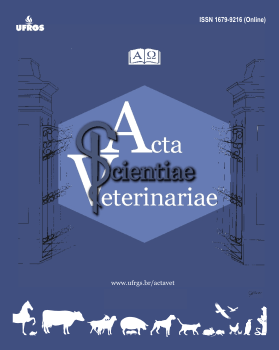Clinical, Laboratorial and Image Aspects of a Perforated Pyloric Ulcer Secondary to Nonsteroidal Anti-Inflammatory Use in a Cat
DOI:
https://doi.org/10.22456/1679-9216.99456Abstract
Background: Inappropriate use of drugs for veterinary patients represents a common problem at clinical practice. Nonsteroidal anti-inflammatories are one of these misused drugs and may lead to clinical status of challenging diagnosis. Adverse effects for patients submitted to its incorrect use may include simple cases such as pharmacological gastroenteritis to severe acute renal failure or perforated gastroenteric ulcers with no pathognomonic clinical signs. The objective of this report was to describe a case of a perforated pyloric ulcer secondary to prolonged use of meloxicam in a cat with its clinical, laboratorial and image aspects from the moment of suspicion until the diagnosis.
Case: An 8-year-old female feline was attended at the Veterinary Hospital of the Dom Bosco Catholic University, with main complaint being a mammary nodule with recent ulceration. Tumor staging and pre-surgical blood analysis were performed previous to total unilateral mastectomy. Eleven days post-surgery the patient was brought for suture removal, but it was observed stupor, moderate dehydration (estimated 10%), 36.7ºC rectal temperature, heart rate at 100 beats/min, respiratory rate at 60 breaths/min, 40 mg/dL blood glucose, icterus and abdominal distension with tympany at percussion (fluid wave test was negative). Anamnesis revealed the possible use of meloxicam for 10 days. The first suspicion was sepsis, with enteric gas secondary to infection. Due to no classical signs of peritoneum effusion and possible severe enteric distension, abdominocentesis was not immediate performed. Complete blood count and serum biochemistry revealed a marked band leukocytosis associated with renal injury, supporting the first sepsis suspicion. Abdominal radiography revealed radiodensity of diffuse aspect at ventral topography but no evidence of marked enteric distension that would justify tympany. Abdominal ultrasound identified effusion predominantly hyperechogenic with hyperechogenic mesentery, indicative of peritonitis. A diagnostic abdominocentesis was performed revealing a dense yellow-green effusion with high suspicion of being gastroenteric liquid. Exploratory laparotomy was not authorized by the owner and the patient was submitted to euthanasia due to the bad prognosis. Macroscopic necropsy was performed and a perforated pyloric ulcer was identified along with an impregnated mesentery with a green-brown color (peritonitis), closing the diagnosis.
Discussion: The importance of reiteration regarding veterinary prescription orientation, especially for feline patients, is evidenced. Along the indiscriminate over-the-counter sale of veterinary drugs, self-medication prior to veterinary consultation is usual even for ongoing assisted patients. Considering the unspecific clinical signs that patients with perforated gastroenteric ulcers may present, the diagnosis may be challenging when no complementary image exams are immediate available. The stuporous mental state inhibiting possible manifestation of abdominal discomfort, absence of positive fluid wave test and tympany at percussion which prohibited a secure abdominocentesis could have led to a delay in diagnosis, if not for image support. Considering the emergency status of these patients, early diagnosis is crucial, therefore clinicians should have precaution when approaching patients with possible perforated gastroenteric ulcers and trust clinical history, even when classical signs of abdominal effusion are not present.
Downloads
References
American Society of Anesthesiologists (ASA). 2014. ASA Physical Status Classification System, 2p. Available at: <https://www.asahq.org/standards-and-guidelines/asa-physical-status-classification-system>. [Accessed online in September 2019].
Brady C.A., Otto C.M., Van-Winkle T.J. & King L.G. 2000. Severe sepsis in cats: 29 cases (1986-1998). Journal of the American Veterinary Medical Association. 217(4): 531-535.
Cariou M.P.L., Halfacree Z.J., Lee K.C.L. & Baines S.J. 2010. Successful surgical management of spontaneous gastric perforations in three cats. Journal of Feline Medicine and Surgery. 12: 36-41.
Daure E., Ross L. & Webster C.R.L. 2017. Gastroduodenal Ulceration in Small Animals: Part 1. Pathophysiology and Epidemiology. The Journal of the American Animal Hospital Association. 53(1): 1-10.
Ford R. & Mazzaferro E.M. 2013. Procedimentos Diagnósticos e Terapêuticos: Procedimentos Avançados. In: Kirk & Bistner Manual de Procedimentos Veterinários e Tratamento Emergencial. Rio de Janeiro: Elsevier, pp.786-787.
Kaneko J.J., Harvey J. & Bruss M. 2008. Clinical Biochemistry of Domestic Animals. 6th edn. New York: Academic, 928p.
KuKanich B., Bidgood T. & Knesl O. 2012. Clinical pharmacology of nonsteroidal anti-inflammatory drugs in dogs. Veterinary Anaesthesia and Analgesia. 39: 69-90.
Lucas G.N.C., Leitão A.C.C., Alencar R.L., Xavier R.M.F., Daher E.F. & Silva Junior G.B. 2018. Pathophysiological aspects of nephropathy caused by non-steroidal anti-inflammatory drugs. Brazilian Journal of Nephrology. 41(1): 124-130.
Weiss D.J. & Wardrop K.J. 2010. Schalm’s Veterinary Hematology. 6th edn. Ames: Wiley-Blackwell, 1232p.
Wooten J.G., Lascelles B.D.X., Cook V.L., Law J.M. & Blikslager A.T. 2010. Evaluation of the relationship between lesions in the gastroduodenal region and cyclooxygenase expression in clinically normal dogs. American Journal of Veterinary Research. 71(6): 630-636.
Zielke M., Carvalho L.F., Salame J.P., Barboza D.V., Gaspar L.F.J. & Sampaio L.C.L. 2018. Avaliação do uso de fármacos em animais de companhia sem orientação profissional. Science and Animal Health. 6(1): 29-46.
Published
How to Cite
Issue
Section
License
This journal provides open access to all of its content on the principle that making research freely available to the public supports a greater global exchange of knowledge. Such access is associated with increased readership and increased citation of an author's work. For more information on this approach, see the Public Knowledge Project and Directory of Open Access Journals.
We define open access journals as journals that use a funding model that does not charge readers or their institutions for access. From the BOAI definition of "open access" we take the right of users to "read, download, copy, distribute, print, search, or link to the full texts of these articles" as mandatory for a journal to be included in the directory.
La Red y Portal Iberoamericano de Revistas Científicas de Veterinaria de Libre Acceso reúne a las principales publicaciones científicas editadas en España, Portugal, Latino América y otros países del ámbito latino





